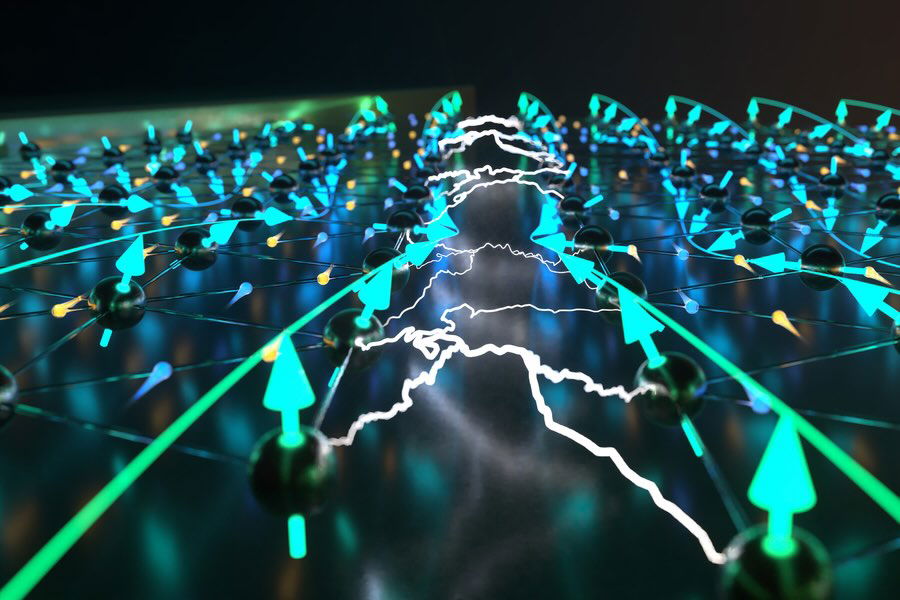MIT physicists have demonstrated a new form of magnetism, marking a significant step toward developing “spintronic” memory chips that could potentially increase computing speed and power efficiency by orders of magnitude.
The phenomenon, known as “p-wave magnetism,” is a hybrid of two well-known magnetic behaviors: ferromagnetism—the force behind everyday magnets like those found in compasses or refrigerators—and antiferromagnetism, where magnetic properties exist only at the microscopic level and cancel out on the macroscopic scale.
Magnetism Explained
In ferromagnets, electrons spin in the same orientation, generating a strong, unified magnetic field. In contrast, antiferromagnetic materials feature alternating spins that neutralize each other at the larger scale. The MIT team discovered p-wave magnetism using a lab-synthesized, two-dimensional nickel iodide (NiI₂) material.
In this material, electrons preferred a particular spin orientation, similar to a ferromagnet, but were also balanced by opposing spins, as in antiferromagnetism. Uniquely, the spins arranged themselves in mirrored spirals, allowing the electrons to “spin switch” and reverse direction when exposed to a small electric field.
This spin-switching process consumes less energy than traditional charge-based data storage, making it a more efficient way to store binary information. If scalable, it could dramatically reduce power consumption while vastly increasing storage capacity.
“We showed that this new form of magnetism can be manipulated electrically,” says Qian Song, a research scientist in MIT’s Materials Research Laboratory. “This breakthrough paves the way for a new class of ultrafast, compact, energy-efficient, and nonvolatile magnetic memory devices.”
Years of Progress
Riccardo Comin, one of the study’s collaborators, had previously worked with nickel iodide, examining its magnetic properties in 2022. That earlier research revealed spiral spin patterns in the nickel atoms within a triangular lattice structure, separated by non-magnetic iodine. Although mirrored spins were observed then, the possibility of precise spin switching had not yet been considered.
That idea came from outside the original group, proposed by researcher Rafael Fernandes, who theorized that aligning opposing spins could produce a p-wave magnetic state. In Comin’s work, Fernandes and colleagues saw potential to realize this by applying an electric field to manipulate the spin configuration for spintronic applications.
“It was a completely new idea at the time, and we decided to test it experimentally because we realized nickel iodide was a good candidate to show this kind of p-wave magnet effect,” Comin says.
Testing P-Wave Magnetism
In the study, the researchers synthesized single-crystal flakes of nickel iodide. They placed powdered elements on a crystalline substrate and baked them in a high-temperature furnace, where the atoms arranged into the necessary triangular lattice.
“What comes out of the oven are samples that are several millimeters wide and thin, like cracker bread,” Comin says. “We then exfoliate the material, peeling off even smaller flakes, each several microns wide, and a few tens of nanometers thin.”
To test for p-wave behavior, the team first examined whether spiral spin patterns caused electrons traveling in opposite directions to exhibit mirrored spins. They did this by exposing the material to a polarized light beam, which rotates in a single direction and creates an electric field. The spins of the nickel atoms matched the beam’s polarization, confirming the expected resonance.
Next, they applied an electric field aligned with the direction of the spin spiral. The electrons responded by spinning in unison along the path, producing a polarized current.
Bringing Spintronics to Life
Currently, the p-wave magnetism effect only occurs at extremely low temperatures—around 60 kelvins—making it impractical for real-world applications. However, the team is now focused on finding materials that exhibit similar properties at room temperature, a critical step toward realizing viable spintronic devices.
“With such a current of spin, you can do interesting things at the device level, for instance, you could flip magnetic domains that can be used for control of a magnetic bit,” Comin explains. “These spintronic effects are more efficient than conventional electronics because you’re just moving spins around, rather than moving charges. That means you’re not subject to any dissipation effects that generate heat, which is essentially the reason computers heat up.”
“We just need a small electric field to control this magnetic switching,” Song adds. “P-wave magnets could save five orders of magnitude of energy. Which is huge.”
The paper “Electrical Switching of a P-Wave Magnet” appeared on May 28, 2025, in Nature.
Ryan Whalen covers science and technology for The Debrief. He holds an MA in History and a Master of Library and Information Science with a certificate in Data Science. He can be contacted at ryan@thedebrief.org, and follow him on Twitter @mdntwvlf.

